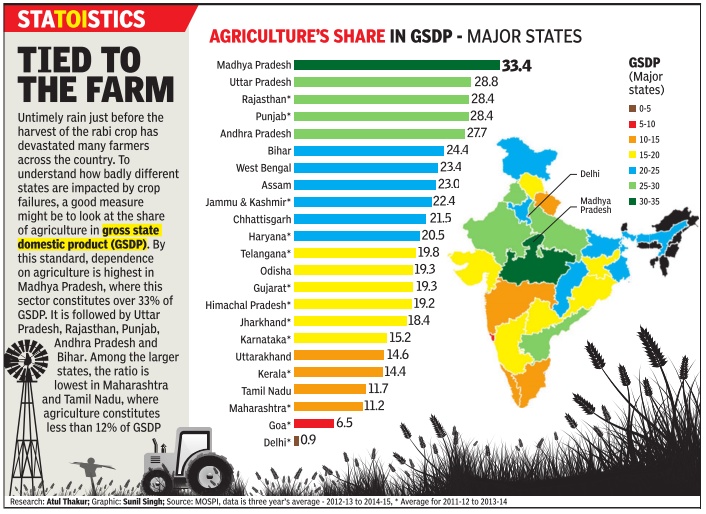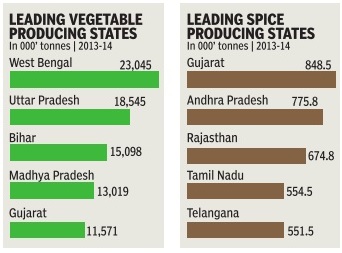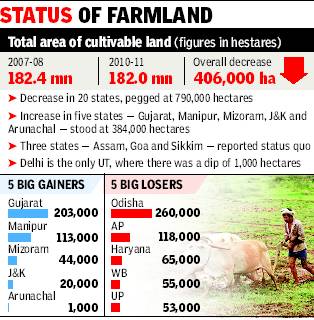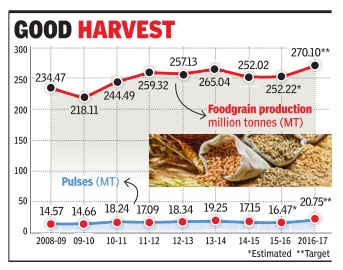Agriculture: India
(→Cereal yield) |
(→Organic farming in India: 2010-14) |
||
| Line 108: | Line 108: | ||
Urging states to promote pulses even in the rabi season beginning October, Singh said, “States should prepare work plans for more coverage of rabi pulses and oilseeds in rain-fed areas.“ | Urging states to promote pulses even in the rabi season beginning October, Singh said, “States should prepare work plans for more coverage of rabi pulses and oilseeds in rain-fed areas.“ | ||
| − | =Organic farming in India | + | =Organic farming in India= |
| + | ==2010-14, lack of financial support to organic farms== | ||
[http://timesofindia.indiatimes.com/India/New-pitch-for-organic-farming-at-Chandigarh-convention-next-week/articleshow/46316528.cms ''The Times of India''] | [http://timesofindia.indiatimes.com/India/New-pitch-for-organic-farming-at-Chandigarh-convention-next-week/articleshow/46316528.cms ''The Times of India''] | ||
[[File: organic.jpg| Organic farming in India: 2010-14|frame|500px]] | [[File: organic.jpg| Organic farming in India: 2010-14|frame|500px]] | ||
| + | |||
The government under a national programme promotes organic farming, ongoing projects and financial outlays that had gone into the process in the past four years does not appear to be enough to match the rising demand of chemical fertilizer-free and pesticide-free food products. | The government under a national programme promotes organic farming, ongoing projects and financial outlays that had gone into the process in the past four years does not appear to be enough to match the rising demand of chemical fertilizer-free and pesticide-free food products. | ||
| + | |||
Organic farming involves an ecological production management system that promotes and enhances biodiversity, biological cycles and soil biological activity in a sustainable manner. Farmers do not use chemical fertilizer and pesticides in such farm practices. | Organic farming involves an ecological production management system that promotes and enhances biodiversity, biological cycles and soil biological activity in a sustainable manner. Farmers do not use chemical fertilizer and pesticides in such farm practices. | ||
| + | |||
Although the government has devised a number of plans to promote organic farming in the country, the extent of financial support under a national programme is quite less. It was just Rs 129.91 crore in 2010-11 under the Rashtriya Krishi Vikas Yojna (RKVY) - a key national programme - to promote organic farming. Though the amount was increased for the purpose to Rs 311.31 crore in 2011-12, it fell down to Rs 143.81 crore in 2013-14. The amount is quite less if one compares it with the total amount (Rs 9968.72 crore in 2013-14) allocated by the Centre to the RKVY for overall promotion of agriculture. | Although the government has devised a number of plans to promote organic farming in the country, the extent of financial support under a national programme is quite less. It was just Rs 129.91 crore in 2010-11 under the Rashtriya Krishi Vikas Yojna (RKVY) - a key national programme - to promote organic farming. Though the amount was increased for the purpose to Rs 311.31 crore in 2011-12, it fell down to Rs 143.81 crore in 2013-14. The amount is quite less if one compares it with the total amount (Rs 9968.72 crore in 2013-14) allocated by the Centre to the RKVY for overall promotion of agriculture. | ||
| + | |||
Financial assistance is provided through state governments for organic village adoption for manure management and biological nitrogen harvesting, promotion of organic input production on farmer's field and promotion of certification for area under organic farming for export purposes. | Financial assistance is provided through state governments for organic village adoption for manure management and biological nitrogen harvesting, promotion of organic input production on farmer's field and promotion of certification for area under organic farming for export purposes. | ||
| + | |||
| + | ==Aquaponic farm/ Gurugram, 2017== | ||
| + | [http://timesofindia.indiatimes.com/city/gurgaon/In-a-first-Gurugram-farmers-set-up-aquaponic-farm-in-north-India/articleshow/55625197.cms Shubhra Pant, In a first, Gurugram farmers set up aquaponic farm in north India, Nov 25, 2016, The Times of India] | ||
| + | |||
| + | |||
| + | GURUGRAM: There is a huge demand for organic farming in the country right now specially after reports of high level of chemicals and toxic in the vegetables being sold in the markets. Many urban dwellers have even taken up kitchen gardening which however, is often restricted due to want of space. | ||
| + | |||
| + | Gurugram based Sushant Madaan is one such organic farming enthusiast who has set up a first of its kind aquaponic farm in Northern India. Aquaponics, a technique that marries horticulture and aquaculture helps the farmer raise fishes while he also grows plants. | ||
| + | "In aquaponics we grow fish and plants together in a tank. The tank has fishes in it and on the sides of the tank there are beds for plants. The water from the fish tank which is rich in nutrients due to the fish waste goes into the plants," said Madaan. | ||
| + | |||
| + | The beds for supporting the plants can be made using material such as thermocol sheets or gravel. Madaan setup the farm in June this year and will be growing only leafy vegetables for this season. | ||
| + | |||
| + | He has done a Master of Science in Sustainable energy systems from Netherlands and Sweden and has been exploring different organic farming techniques for a while. | ||
| + | Madaan says that not only aquaponics is a great way to get organic produce but it is also gaining popularity among urban farmers who are trying it as a hobby. This technique of agriculture is an organic farming technique as there is no use of any fertilisers plus it. | ||
| + | |||
| + | District horticulture officer who has been tracking the project said, "It is the first of its kind aquaponic project in Northern India and is a great technique especially with the ever increasing demand of organic fruits and vegetables in the urban areas," said Deen Mohammad Khan. | ||
| + | Khan added that the technique which is currently new in India is very widely used in countries like Japan and China. According to Madaan, the cost of setting up an aquaponics farm ranges between Rs. 5 lakhs to Rs. 15 lakhs. | ||
| + | While the setup cost of aquaponic farm might be higher than conventional farms, but the operational cost is much less as there is no need for fertilizers and the water requirement is 90% less than that required in conventional farming. | ||
| + | Also the yield from aquaponics is two times higher than that of conventional farming. However, one restriction being that fruits and vegetables which grow underground cannot be grown using aquaponics. | ||
=Quinoa and other S. American seeds= | =Quinoa and other S. American seeds= | ||
Revision as of 23:59, 23 April 2017

This is a collection of articles archived for the excellence of their content. Readers will be able to edit existing articles and post new articles directly |
Contents |
Agriculture reforms
The best performing states, 2015
Maha tops Niti Aayog's agriculture reforms index. Nov 01 2016 : The Times of India
66% Of States Fail To Reach Half Way Mark
Maharashtra is on top of the ladder, followed by Gujarat and Rajasthan, in Niti Aayog's index reflecting states' performance in undertaking agriculture and farm sector reforms.
The first-ever such index, by Niti Aayog, is aimed at ranking states on the basis of implementing agriculture marketing reforms and ease of doing agri-business.
States like Bihar, Kerala and Manipur are not included in the ranking because they either did not adopt Agricultural produce market committee (APMC) or revoked it. “We are talking to them as we think this is not the best thing to do,“ said Ramesh Chand, member of Niti Aayog. Almost two-third of the states could not reach even half way mark of reform score of the index. Major states like UP , Punjab, West Bengal, Assam, Jharkhand, Tamil Nadu and J&K, have poorly performed .
As per the states' score in the in dex, Madhya Pradesh ranked fourth, followed by Haryana, Himachal Pradesh, Andhra Pradesh, Karnataka, Telangana, Goa and Chhattisgarh.An official said, “The index is aimed at helping the states to identify and address problems in the farm sector, which suffers from low growth, low income and agrarian distress.“
Stressing on urgent need to push reforms in the farm sector, Niti Aayog vice-chairman Arvind Panagariya said that post 1991, reforms focused on non-agriculture sector. “Reforms did not focus on the agri sector. One effort was made in 2003 through the model APMC Act reform and some progress was made but not enough and that has led to gap between industry and services on one hand and agri on other hand,“ he added.
The areas identified by Niti Aayog with a view to double farm income include agriculture market reforms, land lease reform, and reforms related to forestry on private land.
Use of modern techniques
The Times of India, Apr 27 2015
Between the 1940s and 1960s, research helped many countries increase agricultural yields. The yield per hectare is an indicator of the use of modern techniques like mechanisation and use of high-yielding varieties as well as improvement of traditional infrastructure like irrigation. The World Bank includes wheat, rice, maize, barley, oats, rye, millet, sorghum, buckwheat and mixed grains to calculate cereal yields. A comparison of India with other major economies shows that India's cereal yield is among the lowest. In 2013, cereal yield in the US was about two and half times that of India.
Cultivable land
Cultivable land continues to shrink
Vishwa Mohan TNN
New Delhi: Cultivable land in India continues to shrink. It may not pose an immediate problem for the nation’s food security but its long-term effect could be disastrous with the country needing more and more foodgrains to support its growing population.
Latest data from the agriculture ministry shows that as many as 20 states reported decrease in cultivable land to the extent of 790,000 hectares in four years from 2007-08 to 2010-11. The decrease is mainly attributed to diversion of cultivable land for non-agricultural purposes, including construction, industries and other development activities.
Since such diversion is inevitable, the government had in its National Rehabilitation and Resettlement Policy (NRRP), 2007 recommended several measures to keep a tab on ever-decreasing cultivable land in the country.
But the data, shared by the agriculture ministry in response to a question in the Lok Sabha on Tuesday, shows that only five states have taken some steps to increase the areas under cultivation and three others (Assam, Goa and Sikkim) have adhered to the policy of not tinkering with land which can be used for farming.
Gujarat is the only big state which increased the area of cultivable land during four years from 2007-08 to 2010-11. Manipur, Mizoram, Jammu & Kashmir and Arunachal Pradesh are the other states which reported increase.
Haryana showed the sharpest decline in area under cultivation. The small state reported decrease of 65,000 hectares of agricultural land between 2007-08 and 2010-11.
Since land falls under the purview of states as per the seventh Schedule of the Constitution, it is for states to bring in suitable policy to prevent diversion of agricultural land for non-agricultural purposes. The Centre had under its 2007 policy advised states to allow development projects to come up on wastelands.
Under NRRP, states were advised that acquisition of agricultural land for nonagricultural use should be kept to the minimum, multicropped land should be avoided to the extent possible for such purposes and acquisition of irrigated land, if unavoidable, may be kept to the minimum.
But it seems most states have not followed the norms, leading to overall decrease of nearly 406,000 hectares of cultivable land in the country during the four-year period.
Harvests, yield (foodgrains, pulses)
Cereal yield
2015: Poor rainfall but kharif sown area rises 12 lakh ha

The Times of India, Sep 25 2015
Despite rainfall deficit, kharif sown area rises by 12 lakh ha Rise in areas under pulses and oilseeds
In what could be an indication of higher foodgrain production, the country this year recorded an increase of nearly 12 lakh hectares in total kharif sown area as on Thursday compared to the corresponding period last year, despite almost similar amount of rainfall deficit during June-September monsoon season. The agriculture ministry figures on kharif sown area show that the total area under summer crops reached 1026.23 lakh hectares as com pared to 1014.24 lakh hectares ast year at this time.
Except cotton and jute, sown area under other major crops, including pulses and oilseeds, increased this year as compared to 2014 reflect ng the positive impact of con ingency measures taken by he government, based on ad vance input of deficit rainfall rom the IMD. Such measures helped farmers in different ways to ensure sowing operation after late revival of monsoon in certain regions.
In fact, sown areas under pulses, oilseeds, sugarcane and cotton are more than normal' sown area of these crops. `Normal' sown area is calculated as an average of sown area of a particular crop in last five years.Though the area under cotton (115.20 lakh hectares) is less than last year (125.75 lakh hectares), it is still higher than its normal sown area (115.02 lakh hectares).
The country has so far reported 12% rainfall deficit, however, this figure will slightly change once IMD comes out with its final report covering June-September period.
Though the initial report estimates slightly less foodgrain production this year as compared to last year, the in crease in sown area shows sign of improvement with some regions witnessing late start of sowing operation.
According to data, the sown area under rice was 374 lakh hectares as compared to 373 lakh hectares last year.While sown area under pulses stand at 113.45 lakh hectares as compared to 101.83 lakh hectares last year, the area under oilseeds reached 183.68 lakh hectares as compared to 177.49 lakh hectares in 2014.
Though the government's first `advance estimate' put the total kharif foodgrain production for the year 2015-16 at 124.05 million tonnes (MT), which is 2.26 MT less than the `actual' kharif output of 201415, it is expected the output would eventually increase backed by higher sown areas under different crops.
2016-17: Good monsoon
Backed by welldistributed monsoon rains this year, India is expected to register a record foodgrain production during the 201617 crop year (July-June). The government has already set a target of 270.10 million tonnes of yield for the year -surpassing its previous record of 265.04 million tonnes in 2013-14.
Though the current year has reported 5% of deficit rainfall so far, adequate rains in July and August, especially in water stressed areas, where it was needed during peak sowing season, has sent positive signals.
Rainfall this year got the water level in major reservoirs up to satisfactory levels as compared to two consecutive drought years of 2015 and 2014 when the country had reported 14% and 12% of deficit rains respectively. This along with good soil moisture condition has signalled the possibility of better rabi season in terms of acreage, making the prospect of achieving the target of record foodgrain production brighter.
“Overall, monsoon has been favourable for farmers this year. We have received good rains and distribution was also good. I am sure, we will have record production this year,“ Union agriculture minister Radha Mohan Singh said while addressing a conference on rabi crops.
The government has a target of 20.75 million tonnes (MT) for pulse production during 2016-17 which includes 13.50MT of pulses output from the rabi season.
Urging states to promote pulses even in the rabi season beginning October, Singh said, “States should prepare work plans for more coverage of rabi pulses and oilseeds in rain-fed areas.“
Organic farming in India
2010-14, lack of financial support to organic farms
The government under a national programme promotes organic farming, ongoing projects and financial outlays that had gone into the process in the past four years does not appear to be enough to match the rising demand of chemical fertilizer-free and pesticide-free food products.
Organic farming involves an ecological production management system that promotes and enhances biodiversity, biological cycles and soil biological activity in a sustainable manner. Farmers do not use chemical fertilizer and pesticides in such farm practices.
Although the government has devised a number of plans to promote organic farming in the country, the extent of financial support under a national programme is quite less. It was just Rs 129.91 crore in 2010-11 under the Rashtriya Krishi Vikas Yojna (RKVY) - a key national programme - to promote organic farming. Though the amount was increased for the purpose to Rs 311.31 crore in 2011-12, it fell down to Rs 143.81 crore in 2013-14. The amount is quite less if one compares it with the total amount (Rs 9968.72 crore in 2013-14) allocated by the Centre to the RKVY for overall promotion of agriculture.
Financial assistance is provided through state governments for organic village adoption for manure management and biological nitrogen harvesting, promotion of organic input production on farmer's field and promotion of certification for area under organic farming for export purposes.
Aquaponic farm/ Gurugram, 2017
GURUGRAM: There is a huge demand for organic farming in the country right now specially after reports of high level of chemicals and toxic in the vegetables being sold in the markets. Many urban dwellers have even taken up kitchen gardening which however, is often restricted due to want of space.
Gurugram based Sushant Madaan is one such organic farming enthusiast who has set up a first of its kind aquaponic farm in Northern India. Aquaponics, a technique that marries horticulture and aquaculture helps the farmer raise fishes while he also grows plants. "In aquaponics we grow fish and plants together in a tank. The tank has fishes in it and on the sides of the tank there are beds for plants. The water from the fish tank which is rich in nutrients due to the fish waste goes into the plants," said Madaan.
The beds for supporting the plants can be made using material such as thermocol sheets or gravel. Madaan setup the farm in June this year and will be growing only leafy vegetables for this season.
He has done a Master of Science in Sustainable energy systems from Netherlands and Sweden and has been exploring different organic farming techniques for a while. Madaan says that not only aquaponics is a great way to get organic produce but it is also gaining popularity among urban farmers who are trying it as a hobby. This technique of agriculture is an organic farming technique as there is no use of any fertilisers plus it.
District horticulture officer who has been tracking the project said, "It is the first of its kind aquaponic project in Northern India and is a great technique especially with the ever increasing demand of organic fruits and vegetables in the urban areas," said Deen Mohammad Khan. Khan added that the technique which is currently new in India is very widely used in countries like Japan and China. According to Madaan, the cost of setting up an aquaponics farm ranges between Rs. 5 lakhs to Rs. 15 lakhs. While the setup cost of aquaponic farm might be higher than conventional farms, but the operational cost is much less as there is no need for fertilizers and the water requirement is 90% less than that required in conventional farming. Also the yield from aquaponics is two times higher than that of conventional farming. However, one restriction being that fruits and vegetables which grow underground cannot be grown using aquaponics.
Quinoa and other S. American seeds
The Times of India, Apr 11 2016
S. America seeds give rich dividends in UP
Arindam Ghosh After giving half a century to farming of pulses and wheat, with depleting yield due to drought or erratic rains, 62-year-old Jagmohan Rajpoot of Rigwara Khurd village in Hamirpur can look forward to a new lease of life -in cultivation of quinoa, a cash crop native to South America that requires minimal irrigation and fetches high price in foreign market. Around 286 farmers have chosen to grow quinoa on 2,100 acres and are earning a handsome profit. They are also growing moringa trees (drumsticks or `sehjan ki phali` as locals call it). Both plants grow in adverse weather conditions and are adaptable to all kinds of soil. Krishan Gupta, MD of an organic products firm said, “We are providing seeds and technical aid and buying the produce at best price besides offering them 5% profit share.“
Krishan's French buyer Pierre Alex Hubber has been dealing in these agriculture products for the past 15 years. During his recent visit to Hamirpur, he said, “ The produce here is pure as crops are being grown in virgin land free from pesticides.“



